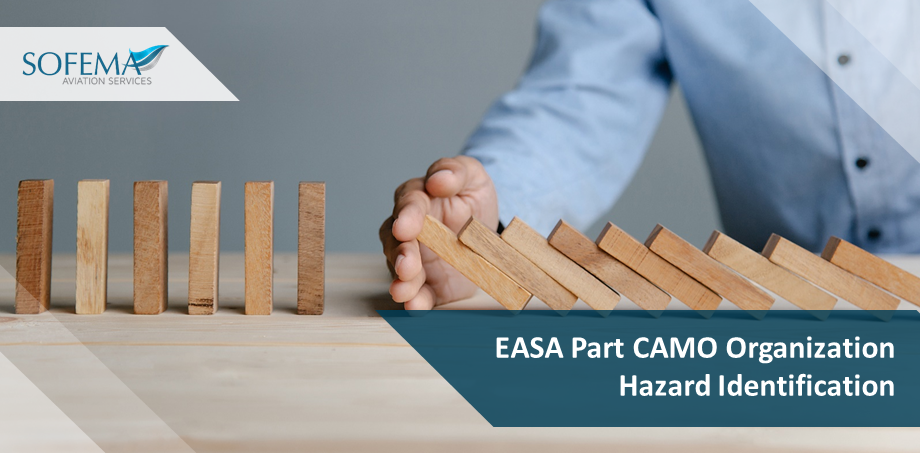Sofema Aviation Services (SAS) considers the Hazard Identification Within an EASA Part CAMO Organisation
Annex VII — AMC and GM to Part-CAMO — Issue 1
Comments by Sofema Aviation Services
For aviation safety risk management, hazards should be focused on those conditions that could cause or contribute to the unsafe operation of aircraft or aviation safety-related equipment, products and services.
Introduction
An important mechanism for proactive hazard identification is a voluntary hazard/ incident reporting system.
(Information collected through such reporting systems may be supplemented by observations or findings recorded during routine site inspections or organization audits)
Hazards can also be identified or extracted from a review of any in-process documentation or from investigation reports, especially those which are deemed to have indirect contributing factors and which may not have been adequately addressed by corrective actions resulting from the investigation process.
Thus, a systematic procedure to review accident/ incident investigation reports for outstanding hazards is a good mechanism to enhance an organization‘s hazard identification system.
What Do We Mean by Hazards?
Well in simple terms it is potentially anything which impacts the role and responsibility of the CAMO which has the potential to cause harm – so could affect People / Equipment / The organisation or Financial Exposure, primarily in respect of safety with secondary exposure to support the “well-being” of the organisation.
A hazard is something that can cause harm, e.g. electricity, chemicals, working up a ladder, noise, a keyboard, a bully at work, stress, etc. A risk is the chance, high or low, that any hazard will actually cause somebody harm.
Hazard identification is a prerequisite to the safety risk management process. Any incorrect differentiation between hazards and safety risks can be a source of confusion.
Understanding our Exposure (Understanding Hazards and Consequences)
A clear understanding of hazards and their related consequences is essential to the implementation of sound safety risk management.
Any hazard that can have an impact (whether directly or indirectly) on the operational safety of aircraft or aviation safety related equipment, products and services should be deemed to be pertinent to an aviation SMS.
To be Clear a Hazard in its self is not necessarily a bad thing, in fact it is a normal component of everyday aviation life.
Our goal, therefore has to be to capture all hazards in such a way that they can be analyzed and assessed, this is one of if not the most challenging part of the organization process.
Whilst Hazards are an inevitable part of aviation activities, their manifestation and possible consequences can be addressed through various mitigation strategies to contain the hazard‘s potential from resulting in unsafe aircraft or aviation equipment operations.
There is a common tendency to confuse hazards with their consequences or outcomes.
Note 1 – A consequence is an outcome that could be triggered by a hazard. For example, a runway excursion (overrun) is a projected consequence in relation to the hazard of a contaminated runway.
By first defining the hazard clearly, one can then project the proper consequence or outcome.
Note 2 – It may be noted that the consequences of a particular Hazard can be multi-layered, including such as an intermediate unsafe event, before an ultimate consequence (accident).
Whilst the ultimate consequence could be an accident, the damaging potential of a hazard in fact materializes through one or many consequences.
How to Describe Consequences
It is therefore important for safety assessments to include a comprehensive account of all likely consequences described accurately and in practical terms.
The most extreme consequence, loss of human life, should be differentiated from those that involve the potential for lesser consequences such as increased flight crew workload, passenger discomfort or reduction in safety margins.
The description of consequences according to their plausible outcomes will facilitate the development and implementation of effective mitigation strategies through proper prioritization and allocation of limited resources.
Hazard Identification
Proper hazard identification leads to appropriate evaluation of their potential outcomes.
Hazards should be differentiated from error, a normal and unavoidable component of human performance, which must be managed.
Hazards exist at all levels in the organization and should be detectable through use of reporting systems, inspections or audits.
Mishaps may occur when hazards interact with certain triggering factors. As a result, hazards should be identified before they lead to accidents, incidents or other safety related occurrences.
What`s more :
Next Steps
Follow this link to our Library to find & Download related documents for Free.
Please visit Sofema Aviation Services or Sofema Online for Classroom, Webinar & Online Training.
For questions and comments please email team@sassofia.com
Tags:
aviation safety, Hazard and Risk Identification, Safety, Hazard, Aviation SMS, EASA Part – CAMO, Part CAMO





